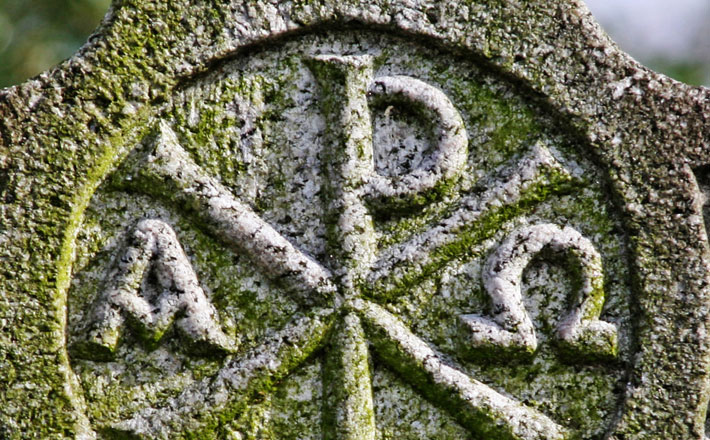Commentary on Revelation 22:12-14, 16-17, 20-21
The conclusion of Revelation has seemed to many interpreters to be a bit choppy, a barely-held-together conglomeration of leftover pieces, stumbling toward the close of the book.
Whether it is made more or less choppy by the piecemeal selection of verses in the lectionary, it is obvious that the lectionary has decided to omit the verses of warning. Such a move may be understandable, but it runs the risk of making the close of this book too comfortable and too unremarkable. Revelation’s call to faithful witness is a matter of life and death, and the lectionary’s careful selection of verses may make it difficult for us to hear that.
Despite the sense that these verses carry us along on a nearly chaotic rush to the end of the book, John is in fact bringing the book to a careful, deliberate, and theologically precise end. These verses are filled with echoes of the whole story John has told: “alpha & omega” (22:13; see 1:8), the washed robes (22:14a; see 7:14), the tree of life (22:14b; see 2:7 and 22:2), the gates of the city (22:14b; see 21:21, 25), the interpreting angel (22:16; see 1:1), the root of David and the morning star (22:16; see 5:5 and 2:28), the bride (22:17a; see 21:9), the water of life (22:17b; see 7:17 and 22:1). The overwhelming promises of God’s salvation made throughout the book are reaffirmed here at the end with this cascade of images.
Verse 17 begins with a repeated exhortation/invitation to “come,” but to whom is that invitation being made? It would be possible to read the first two phrases of verse 17 as the evangelical outreach of the church, the word directed to all those outside the church, all those who may still find themselves outside the New Jerusalem described by John. However, it is probably better to take the first part of verse 17, the words of the Spirit and the bride and all who hear, as the church’s prayer for the coming of Jesus.
The appeal to “come” echoes Jesus’ own promise in verse 12, and it becomes more explicit as the prayer of the church in verse 20b. All that John has shown is testimony to the faithfulness of God and the Lamb, a revelation of the divine intention to redeem all creation from the grasp of sin, death, and the devil; to this, the church joyously responds with prayer and longing for that coming. The church can make this prayer because what John has shown in this book is not just a bunch of end-time events, but the One who is Lord of both beginning and end. We have not been shown a timetable, but a person, the Ruler of church and cosmos.
The last sentence in verse 17, however, changes the address. No longer is this a prayer to the Lord Jesus, but it is now directed to all those who thirst for the life and deliverance that this book has promised. It is an invitation both to those already inside the community of the Lamb, and to all those still outside: to all who thirst for this gift of life.
In verse 20, we hear Jesus declare that he is “coming soon.” It would seem that John’s book is wrong at this point. We cannot simply spiritualize and individualize this promise, turning it into an existential coming at all times. To do so would rob John’s apocalypse of its ability to confront the power of the beast as it shows up in all the world’s oppressive structures and systems. John declares a coming of Christ that is not internal or private, but a coming to the world, to redeem the world. Despite the apparent error about the timing, what John conveys is a sense of urgency, the promise and realization that God could invade the world’s history at any time. Where the empire and oppression seem to hold the day, John shows that in fact God and the Lamb are already reigning and already bringing sin, death, and the devil to their ultimate end. We see it in the resurrection of Jesus, and we experience a foretaste of it in the Eucharist.
It is to that table that the end of Revelation brings us. “Come Lord Jesus” is how the table prayer which I learned as a child begins. It is also the Eucharistic table prayer of the church, and has been from very early in the church’s life. The 2nd century Didache places this prayer within the Eucharistic liturgy (Didache 10:6; see 1 Corinthians 16:22, Luke 22:16). The water of life is not only available at the end, in the New Jerusalem, but is present already, because the Lamb reigns already. Verse 17 is often (and rightly) heard as an invitation and transition to the Eucharist within John’s churches. In worship, through Word and Sacrament, Jesus comes to us as the ultimate End of the universe. It is there the church joyfully submits to his dominion, refuses to bow down to the cult of human self-interest, and finds the beastly deception of earthly empire exposed.
Revelation ends with one final surprise, in the form of a textual variant in verse 21. Is grace declared to “all the saints” (NRSV text), or “to all” (NRSV footnote)? The shorter reading is probably the more original. Later scribes apparently found such grace problematically broad and so tried to limit it to the church. However, “to all” is a fitting final declaration for this book: God reaches out not just to the church, but to all the world, graciously beckoning all into the New Jerusalem. Everything that John has seen and shown, in the end, is God’s grace. In this book, as in all our lives, God’s grace is both beginning (1:4) and ending (22:21).


May 16, 2010